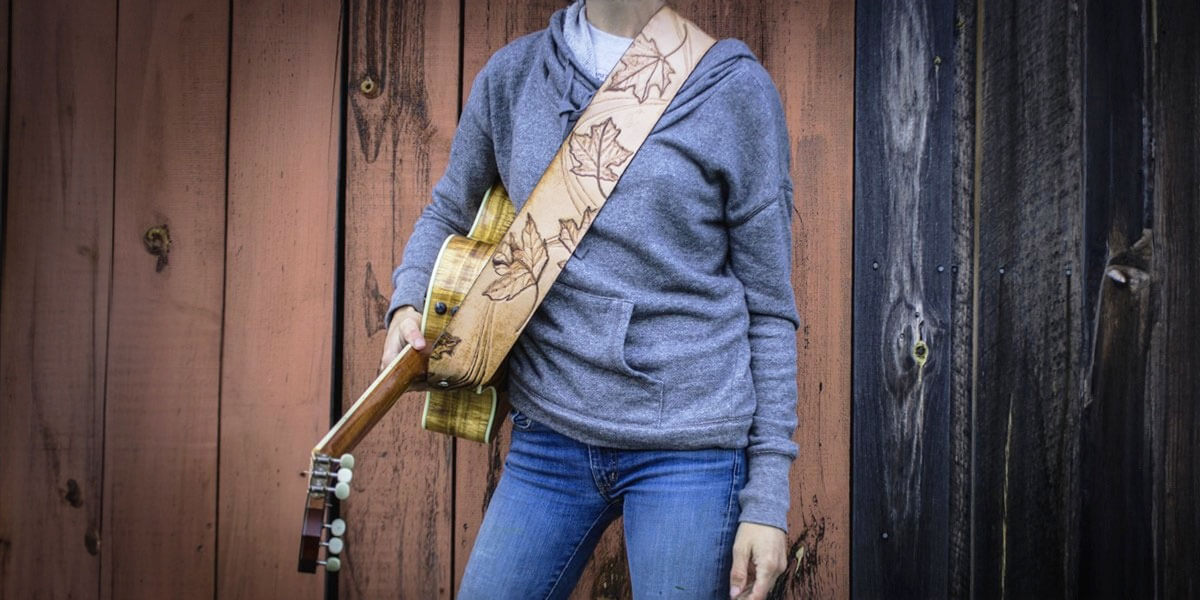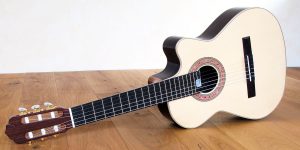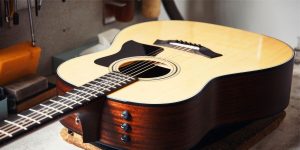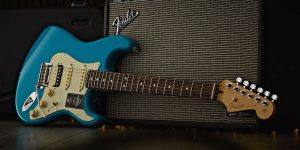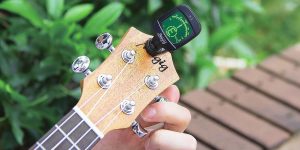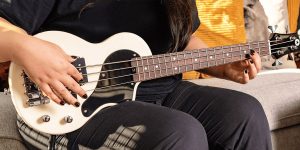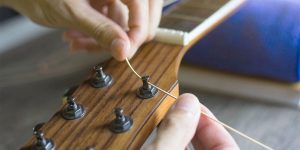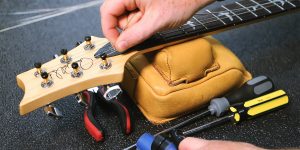Don’t look further if you’re just starting your musical career and are wondering how to wear a guitar strap. In this article, I’ll tell you everything you need to know about different types of guitar straps and how to put on a guitar strap correctly so that you look cool when playing in front of your audience on the stage and minimize any potential accidents.
Different guitar strapping methods

Let’s start by taking a quick look at the different guitar strapping methods that exist. This will give you an idea of which one of them best suits your playing style and preferences.
| Standard Attachment with Strap Buttons | Headstock Attachment | Soundhole Attachment | |
|---|---|---|---|
| Recommended for | Electric guitars and acoustic guitars | Acoustic guitars | Classic guitars, ukuleles, and some acoustic guitars |
| Pros | Simple and secure. The strap doesn’t move unless a player purposefully adjusts it. | Even distribution of the weight of the guitar across the body. More natural playing angle. | Suitable for the majority of guitar models, including those without strap buttons. |
| Cons | Requires permanent modification. | Limited compatibility. | This method can potentially dampen the guitar’s resonance. |
Ways to put on a guitar strap
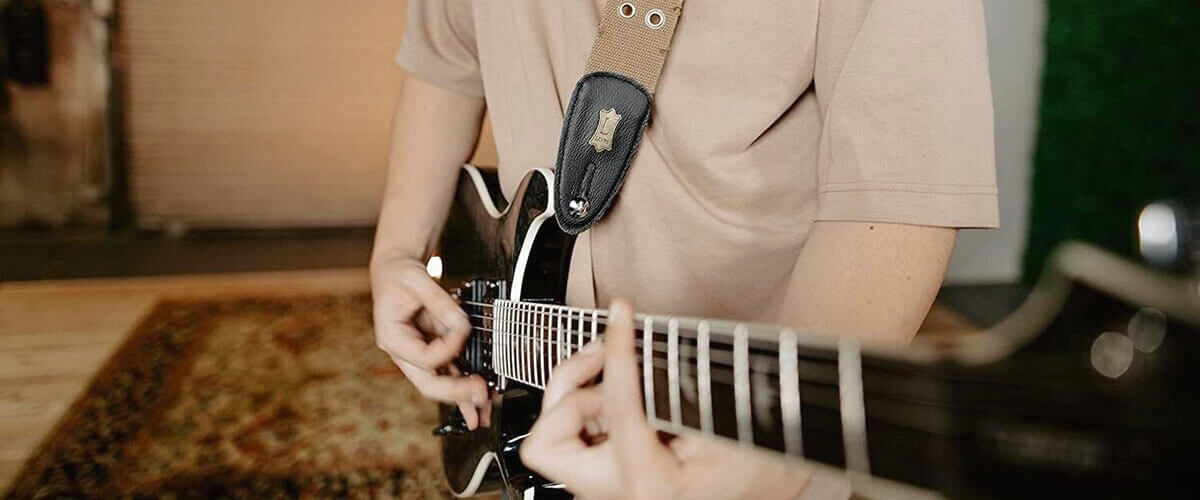
Method 1: standard attachment
- Make sure you have the correct strap.
When choosing the right guitar strap, consider the guitar strap width and length. It should be promotional to your body size. - Locate the strap buttons on the guitar.
As a rule, a guitar features two strap buttons — one at the bottom of an instrument’s body and another near the neck joint. If yoursdoesn’t have a second button, you need to drill one. - Identify the strap ends.
The widest end with embroidered logos is attached to the bottom of a guitar’s body. In case both ends are the same size, attach guitar strap with an end where layers overlap to the guitar’s base. - Put the ends of the straps on the buttons.
Make sure the button goes all the way through the hole. Otherwise, the strap may come off at the most inappropriate moment. - Adjust the length.
Finally, adjust the guitar strap length so that nothing interferes with your playing.
Method 2: headstock attachment
- Make sure you have the correct strap.
For this method, use a guitar strap that has either special ropes or a narrow end. This will allow you to easily attach it to the neck of the guitar. - Locate the strap buttons on the guitar.
In general, the first three steps are not much different from the standard stripping method. The only difference is that headstock attachment is typically applied to acoustic guitars that have only one button. - Choose the attachment point and thread the strap through.
Take the narrowest end of the strap and thread it under the strings of the guitar. You’ll need to run it through the strings between the nut (the white part at the top of the neck) and the tuning pegs. - Create a loop and tie a secure knot.
After threading the strap through the strings, pull the narrow end through until it’s long enough to form a loop around the headstock. Tie a secure knot at the narrow end of the strap, making sure it’snug against the headstock. This knot will hold the strap in place. - Adjust the length.
Once you have put a strap on an acoustic guitar, ensure that the length of the strap is adjusted to a comfortable and ergonomic playing position.
Method 3: soundhole attachment
One of the most universal strapping methods, suitable for virtually all stringed musical instruments, regardless of their design or shape, is the soundhole attachment. This approach, as the name suggests, involves threading the strap through the guitar’s soundhole. The advantage of this method is that it can be used for guitars without strap buttons. However, it’s important to choose a high-quality strap designed for soundhole attachment to ensure stability and prevent sound quality degradation.
What are the guitar strap types?
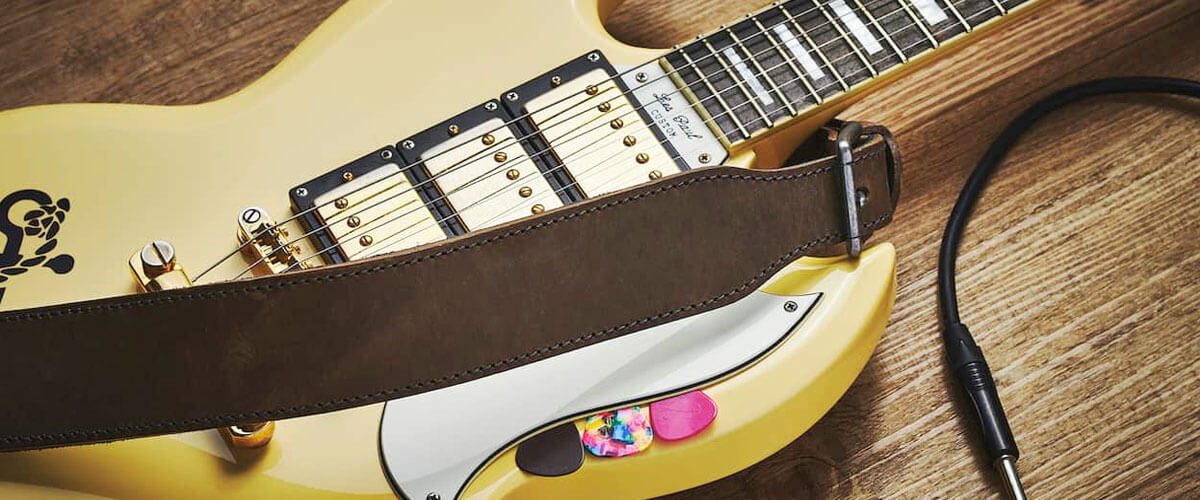
If you’re still in doubt about which type of strap to choose, below, I’ve put together a list of recommendations based on existing guitar types and music styles to help you make up your mind.
| Nylon straps | Leather straps | Fabric straps | Padded straps | Woven straps | |
|---|---|---|---|---|---|
| Recommended guitar types | Lightweight acoustic and electric guitars | Lightweight and heavy stringed musical instruments | Can be used with all types of guitars | Acoustic-electric or solid-body electric guitars | All guitar types |
| Playing style | All styles and genres of music playing | Versatile for all styles | Ideal for those seeking ways to express themselves | Fingerstyle, live performances, extended rehearsals, and recording sessions | Rock, alternative, country, Americana, and many other genres with down-to-earth vibes |
| Pros | Durable and length-adjustable | Offer comfortable grip, premium design, and longevity | Available in a wide range of colors, designs, and patterns | Additional cushioning in the shoulder area | Look utterly stunning and feel quite comfortable |
| Cons | Not extremely stable | May stretch over time | The movement of the strap is limited | Can trap heat, causing sweating | Prone to fraying and wear |
Although this list doesn’t cover all the options available, I’ve focused on the most popular straps that are widely used by guitarists and deserve your attention.
Locking Mechanisms for guitar straps

How securely the strap will hold the guitar depends on its locking mechanism, which provides an extra layer of protection by preventing the strap from coming loose while you play. Let’s look more closely at the types of locking mechanisms you can choose from.
Strap locks
Straps locks are special devices designed to replace the existing strap buttons on your guitar. They consist of two main components: a button that attaches to the guitar and a locking mechanism that fastens to the strap. The locking mechanism securely clicks on the button, preventing the strap from loosening.
Twist locks
Twist locks, also known as quick-release locks, provide a secure yet quick way to attach and detach your guitar strap. They allow for easy removal of the strap without compromising stability during play. Moreover, this type of locking mechanism is versatile, allowing you to use it with any guitar strap of your choice. The only thing to note is that it is often installed by replacing the existing strap button, requiring a slight modification to the guitar.
Strap blocks
Strap blocks are made of rubber or plastic that grip onto the strap buttons, preventing them from coming loose. They create friction and resistance to keep the strap in place. Strap blocks are a favorite choice of many guitar players due to their simplicity of installation and secure grip.
FAQ
Can I use the same strap for both electric and bass guitars?
Yes, you can put a guitar strap on the electric guitar and bass guitar. Both instruments have strap buttons, making the process of putting a guitar strap essentially the same.
Are all strap buttons the same size?
Strap button sizes can vary, especially when comparing bass strap vs guitar strap setups. This is because some basses might have larger strap buttons to accommodate the instrument’s weight.

